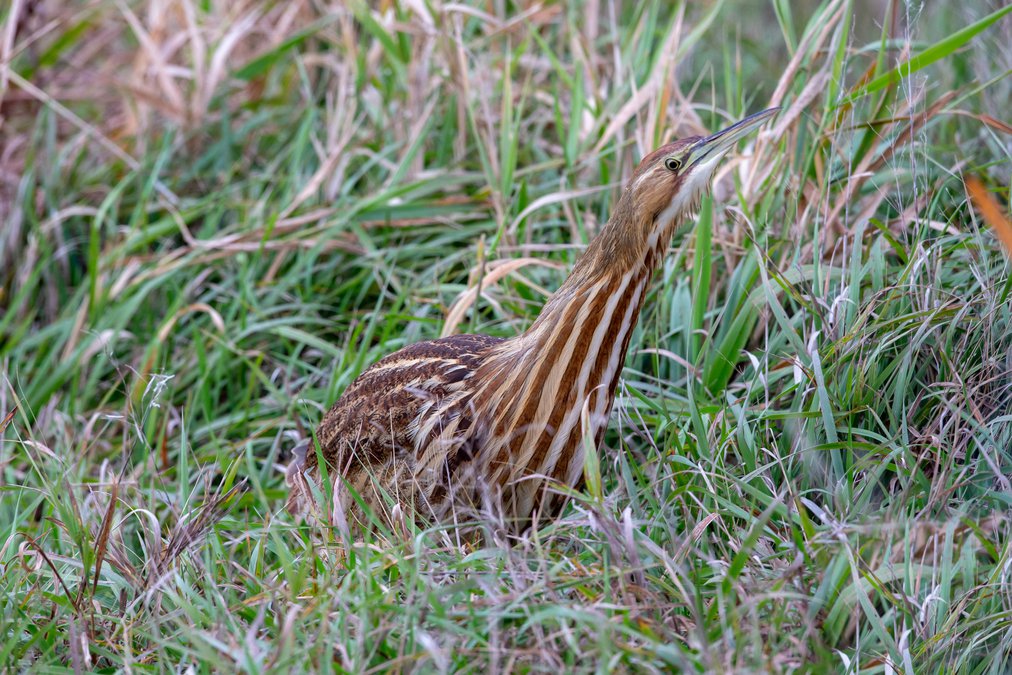

The common birds in our marsh can keep us entertained almost to eternity it seems. Their activities are active and educational. Curtis and his crew at KWEC keep a close watch on all the birds as best they can. The “odd” or “uncommon” birds get a welcome and a platform, but nobody has time to dink around and follow some of the less-well-known characters in our wetlands — except dedicated birders and old retired guys. It seems that I fall into one of the latter categories and I’m not that good at birding.
One of these birds is the American Bittern. You have probably heard them “screech” more than you have seen them. They are a large member of the heron family. They stand in the reeds or brush and extend their neck and head upward as if stargazing. The beautiful brown/white streaked markings make them difficult to see. When they walk, it is agonizingly slow and precise like a cat taking “sneak steps” to get ready to pounce on a mouse. They seem to have a somewhat unpleasant disposition and can screech with the best when disturbed or flushed. If you drive the roads right now, you have an excellent chance of seeing one along the dike road from headquarters east to the first turn. I have been out there fairly frequently lately and have seen several.
They are called by several nicknames — “thunder-pumper,” “water-belcher” and “stake-driver.” My friend Jimmy New from Russell and Canada and Costa Rica discovered one of the earliest nests at the Bottoms when he was a biologist at the site. He has some grand memories of the early days at the Bottoms and has been very kind to share some of them with me. The Bittern’s yellow eyes turn orange during breeding season. A dedicated birder made that observation.
Another “fun bird” is the Merlin. They are not very common but are sure fun to watch when you find one. They are a small falcon. You are more familiar with the Peregrine Falcon which has been followed with live video when nesting on skyscrapers in the city. Those birds are well-colored falcons and are easy to identify. The Merlin is mostly brown with a black-barred tail. Most of the Merlins I have seen were eating something — usually blackbirds at the Bottoms. They are fast, aggressive and all business when collecting lunch. They are shy and flush easily, just out of perfect camera range in my experience, and absolutely HATE being disturbed when dining. We had one in Hoisington that lived in the trees on the west side of the hospital — made for great entertainment on my morning walks. You might confuse the Merlin with a Prairie Falcon or an American Kestrel or a Peregrine. Get your bird books out and figure it out as I do. They are terrific birds.
Whooping Cranes are migrating through the Bottoms and Quivira with regularity right now. They seem to be stopping on the Nature Conservancy north of the Brinkman lot on the backside of pool 2. That main parking lot is flooded, so be careful and stay on the road. I’ve had experience with off-road and it is time-consuming and tedious and slightly embarrassing.
There are Yellow-legs, Least Sandpipers, Avocets, Dowitchers, Snipe and LOTS of ducks that are beautiful, geese and Sandhill Cranes. You won’t be bored, the water is receding so you won’t get stuck, and the sounds of our marsh will stir your soul. It is the perfect time to take a drive with the windows down. Take your binoculars; there is lots of big water to peruse.
Doc
Doctor Dan Witt is a retired physician and nature enthusiast.





